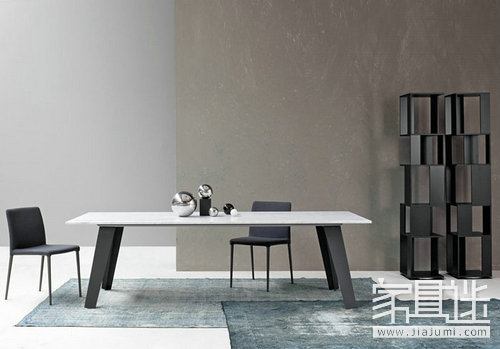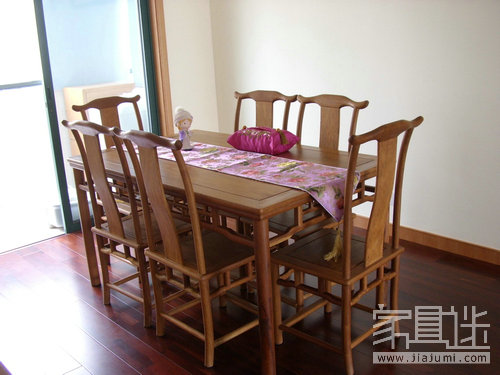The dining table plays a crucial role in any restaurant or home setting. Before purchasing one, it's essential to understand the standard dimensions and how it complements the existing furniture, especially in terms of style and overall decor. Choosing the right dining table not only enhances the aesthetics of your space but also ensures comfort and functionality for those who use it.
★ Types of Dining Tables
Dining tables come in various shapes and styles, making it easier to find one that suits your needs. They can be categorized by shape—round, square, or rectangular—and by the number of people they accommodate, such as two-person, four-person, six-person, eight-person, ten-person, twelve-person, or even larger banquet tables. Based on their purpose, they can be divided into household and commercial tables. In terms of design, you’ll find Chinese, European, modern minimalist, American, Japanese, and Korean styles. Materials vary too, including mahogany, metal, stone, glass, leather, bamboo, rattan, and synthetic fabrics. Selecting the right type depends on your personal taste and the overall theme of your home.

★ The Size of the Dining Table
In most homes, square and round tables are the most common. According to standard measurements, the height of a dining table typically ranges from 750 to 790 mm, while chairs should be between 450 and 500 mm high. When seated, your feet should rest flat on the floor, with your thighs and calves forming a right angle. Your arms should hang naturally, with your upper and lower arms also at a right angle. This setup ensures a comfortable and ergonomic seating arrangement.
1. Round Table Dimensions
Round dining tables are great for maximizing limited space due to their compact footprint and flexible layout. Common sizes include: 500mm (for two people), 800mm (three people), 900mm (four people), 1100mm (five people), 1100–1250mm (six people), 1300mm (eight people), 1500mm (ten people), and 1800mm (twelve people). In smaller homes, a 1100mm diameter table is often more practical, offering enough space without overwhelming the room.
2. Square Table Dimensions
Square and rectangular tables vary in size depending on the number of seats. Typical sizes include 760x760mm for small spaces, 1070x760mm for medium setups, and 2250x850mm for larger gatherings. The width should be at least 700mm to avoid discomfort from cramped seating. A standard table height is around 710mm, paired with a chair height of about 415mm. For example, a two-person table might measure 700x850mm, while an eight-person table could be 2250x850mm.

★ The Distance Between the Dining Table and the Wall
When placing a dining table, consider the distance between the table and the wall. Ideally, this should be around 80cm to allow for easy movement and comfort. This space allows guests to pull out chairs and move around without feeling cramped. A lack of sufficient space can make meals uncomfortable, so it’s important to plan accordingly.
★ Chinese Dining Etiquette
Dining etiquette has deep roots in Chinese culture, with formal rules dating back to the Zhou Dynasty. Confucius emphasized proper behavior, which became a key part of social customs. Traditional banquets involved specific seating arrangements, where the host would greet guests at the door, guide them to the living room, and seat them according to rank. Elders and honored guests were given priority, and serving order was carefully observed.
During the Qing Dynasty, Western influences introduced new practices like shared dishes and individual servings, adding to the evolution of Chinese dining customs. Today, modern Chinese banquets blend traditional values with Western-style seating, where the host sits to the right of the main guest.
The order of serving dishes follows a traditional pattern—starting with hot dishes, followed by cold ones. Dishes should be placed on the left side of the guest, and certain items like whole fish or chicken should not face the main seat directly. These customs help maintain harmony and respect during meals.
★ Seat Etiquette
Guests should be seated first, entering from the left side of the chair. Once seated, avoid moving chopsticks or making noise. If something needs to be said, politely address the host.
★ Eating Etiquette
Let elders and guests take the first bite. Avoid eating too quickly or making loud noises. When drinking soup, use a small spoon and don’t drink directly from the bowl. If the food is too hot, wait until it cools down before consuming.
★ Other Important Rules
Avoid making noise while eating, such as sneezing or burping. If it happens, apologize politely. When passing dishes, use public chopsticks or serve them directly to the person. Never spit bones or food scraps on the ground; place them in your own dish instead.
It’s also good to engage in light conversation with neighbors to keep the atmosphere friendly. Don’t eat with your head down or devour large portions. Avoid picking your teeth at the table unless necessary, and if you must, cover your mouth with a napkin.
Finally, when leaving, thank the host and consider inviting them to visit your home as a gesture of respect. These simple actions reflect good manners and appreciation for the hospitality provided.
TRITAN baby bottle,TRITAN milk bottle,TRITAN feeding bottle,Triphenylmethane copolyester bottle
Guangzhou Liben Plastic Industry Co., LTD , https://www.libenbaby.com